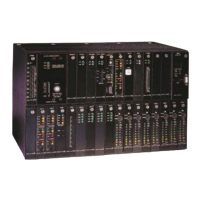Chapter 5. Diagnostics
171
T1 Transmission Tests
T1 Transmission Tests cover initial testing for channel bank, drop-and-insert, and dual channel bank
operation. Testing with the Dual Standard DSX-1 Interface Unit, Dual Enhanced DSX-1 Interface Unit,
and Dual CSU Interface are described for each mode of operation.
The initial testing of the D/I Mux III verifies the following system responses:
• Local Alarm
• Remote Alarm
• Carrier Group Alarm (CGA)
• Alarm Cut-Off (ACO)
• Bypass
T1 Interfaces
Diagnostic capabilities change depending upon the type of T1 Interface installed in the system.
The Dual Enhanced DSX-1 Interface (P/N 30118-102) includes a test jackfield. Local loopbacks can
only be performed through the jackfield with bantam cables and dummy jacks, or at the DB-15 or RJ-48
T1 interface connectors. Test equipment can access and monitor signals through the jackfield. See
Figure 5-4 for a jackfield explanation.
The Dual CSU Interface Unit (P/N 30318-10X) has the capability to perfomr local and remote software
loopbacks without cables or loopback connectors. However, the Dual CSU Interface also has a jackfield
which allows for hardware testing with bantam cables and plugs. To test Channel Service Unit (CSU)
circuitry, loopbacks must be placed at either the DB-15, or the RJ-48, T1 interface connectors. Refer the
Chapter 3 for more information on the Dual CSU Interface unit. See Figure 5-5 for a jackfield
explanation.
The Dual Standard DSX-1 Interface (P/N 30118-101) has the fewest T1 diagnostics. It requires
loopback connectors for T1 testing. A T1 loopback connector connects the T1 output to the T1 input.
For the DB-15 connector, pin 1 connects to pin 3, and pin 9 connects to pin 11. For the RJ-48
connector, pin 1 connects to pin 4, and pin 2 connects to pin 5. (See Figures 5-2 and 5-3 for T1
loopback connector details.)

